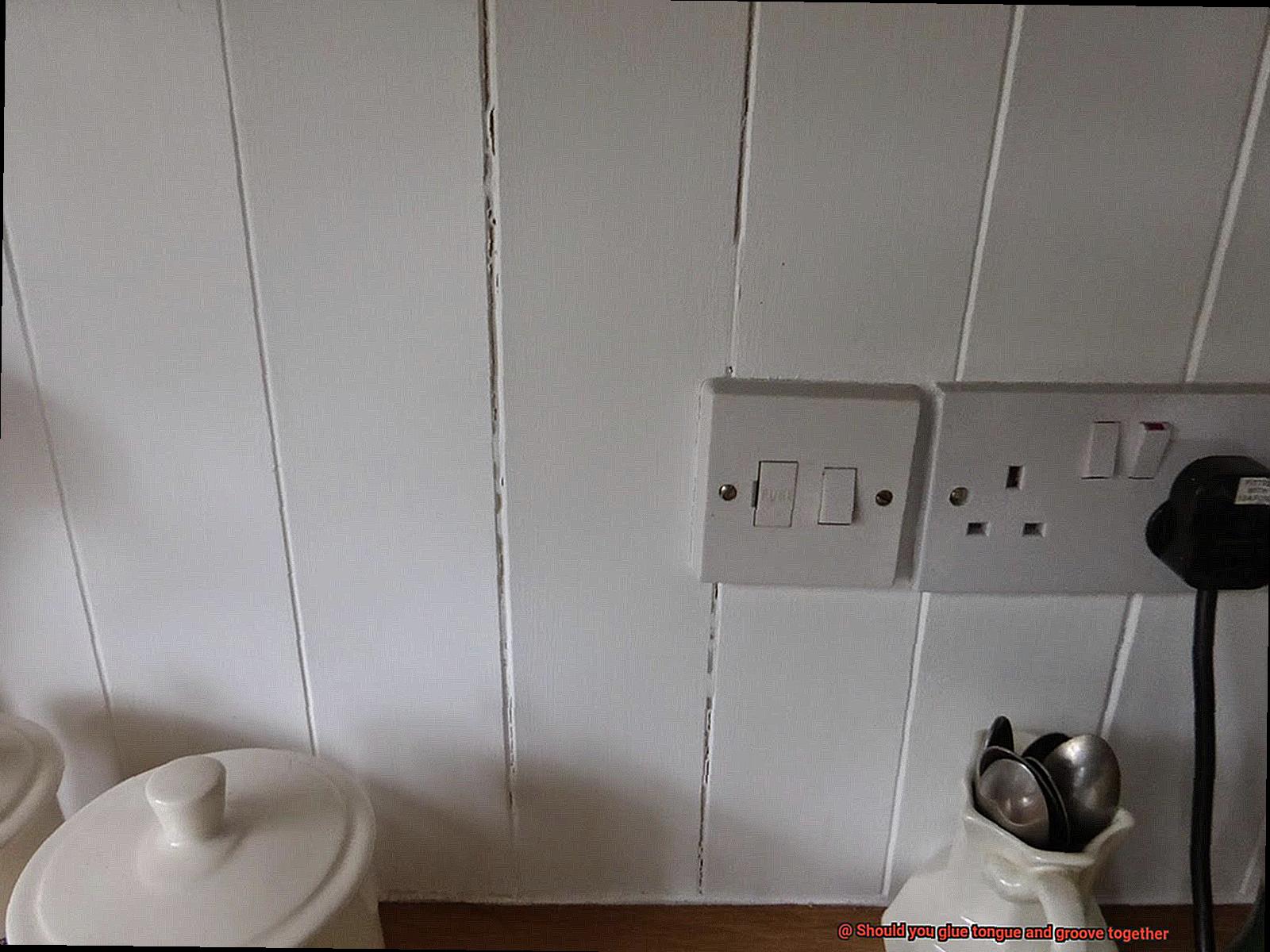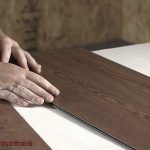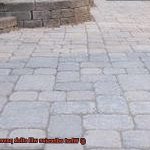The eternal question of tongue and groove boards: to glue or not to glue? It’s a hot topic that has sparked debates among DIY enthusiasts and seasoned professionals alike. Some swear by the power of glue for added stability, while others argue it stifles the wood’s natural movement. So, what’s the right answer?
In this blog post, we’re diving deep into the pros and cons of gluing tongue and groove boards together. By exploring both sides of the argument, we’ll help you make an informed decision about whether to grab that glue bottle or let your boards roam free.
Should you glue tongue and groove together?
Contents
- 1 Should you glue tongue and groove together?
- 2 What are tongue and groove joints?
- 3 Factors to Consider When Deciding Whether to Glue Tongue and Groove Boards Together
- 4 Softwoods vs Hardwoods
- 5 Flooring Applications
- 6 Disassembly Considerations
- 7 Alternatives to Glue for Securing Tongue and Groove Boards
- 8 Practical vs Aesthetic Factors
- 9 Weighing the Pros and Cons of Gluing Tongue and Groove Boards Together
- 10 Conclusion
Pros of Gluing Tongue and Groove Boards:
- Enhanced Stability: Picture this – glued boards holding hands tightly, preventing any unwanted movement or pesky gaps from popping up over time.
- Moisture Resistance: Say goodbye to warping and cupping. Glue seals those joints tight, keeping moisture at bay in humid or damp areas.
- Noise Reduction: No more creaking floors or unsettling paneling shifts. Glued tongue and groove joints create a solid, silent experience.
Cons of Gluing Tongue and Groove Boards:
- Limited Flexibility: Wood loves to dance with temperature changes and humidity levels. But gluing can put a damper on its moves, leading to stress buildup and potential damage down the line.
- Difficult Repairs: Once glued, individual board replacements become as tricky as solving a Rubik’s Cube blindfolded. Breaking that strong bond is no walk in the park.
- Time and Effort: Brace yourself for some extra work. Gluing tongue and groove boards adds complexity to your installation game. Precision, patience, and proper adhesive application are key players here.
To glue or not to glue tongue and groove boards together? That is the question. Ultimately, it depends on your project and what you hope to achieve. Gluing can amp up stability and protect against moisture, but it may sacrifice flexibility and make future repairs a headache.
Before making a decision, consider factors like your environment, budget, and overall goals. And don’t forget to consult experts or check manufacturer recommendations for your specific type of tongue and groove boards.
Armed with knowledge and understanding, you’ll confidently choose whether to stick those boards together or let them go their separate ways. The power is in your hands.
What are tongue and groove joints?
In the world of woodworking, the tongue and groove joint reigns supreme as a method for creating strong and seamless connections between wooden pieces. This joint, with its tongue-like projection on one piece of wood fitting perfectly into a corresponding groove on another, offers not only structural integrity but also an aesthetic appeal that is hard to resist.
However, when it comes to enhancing the strength and stability of these joints, a question arises: should tongue and groove joints be glued together?
In this blog post, we will dive into this topic, exploring the factors that influence the decision to glue or not to glue tongue and groove joints.
Consider the Wood Type:
Before delving into the glue-or-not-to-glue debate, it is essential to consider the type of wood being used. Softwoods like pine or cedar have a propensity to expand and contract significantly with changes in humidity. Gluing these boards together may restrict their natural movement, potentially leading to issues such as warping or buckling over time. Conversely, hardwoods like oak or maple are generally more stable, making gluing a viable option for enhancing joint strength and stability.
Purpose of Installation:
The purpose of the installation also plays a crucial role in determining whether gluing is necessary for tongue and groove boards. For high-traffic areas like flooring, gluing can help prevent squeaking or shifting underfoot. However, for applications where disassembly may be necessary, such as removable paneling or furniture, gluing can make it difficult or even impossible to separate the boards without causing damage.
Alternative Methods for Secure Connections:
Even if gluing is not necessary or recommended for a particular project, there are alternative methods to ensure a secure connection between tongue and groove boards. Using nails or screws through the tongues into the subfloor or framework can provide added strength without compromising the integrity of the joint. This approach allows for disassembly if needed while still maintaining stability.
Weighing the Benefits and Drawbacks:

When deciding whether to glue tongue and groove joints, it is crucial to evaluate the benefits against potential drawbacks. Gluing provides added strength and stability, making it ideal for certain applications. However, it may limit flexibility for future modifications or repairs. Therefore, it is advisable to carefully consider the project’s practical and aesthetic requirements before making a final decision.
Factors to Consider When Deciding Whether to Glue Tongue and Groove Boards Together
Tongue and groove boards are a popular choice for a variety of woodworking projects, from flooring to paneling to furniture. They provide a strong and secure connection between boards, thanks to their interlocking design. But should you take it a step further and glue them together? Let’s explore the key factors to consider when making this decision.
First and foremost, think about the purpose of your installation. If you’re working on a project that requires utmost stability and rigidity, such as flooring or paneling, gluing the tongue and groove boards together can provide added strength. The glue creates a bond between the boards, preventing any movement over time. However, if you’re working on a project that requires flexibility or may need to be disassembled in the future, like furniture or decorative wall coverings, it’s best to leave the boards unglued. This allows for easy disassembly and replacement of individual boards if needed.
Next, consider the climate and environmental conditions in which your tongue and groove boards will be installed. Wood is a natural material that expands and contracts with changes in temperature and humidity. Gluing the boards together can help minimize these movements by creating a strong bond. However, in extreme environments where there is high humidity or dryness, glued joints may become stressed and potentially fail over time. It’s important to assess the specific climate conditions before deciding whether gluing is necessary.
The type of glue used is also crucial in determining the strength and durability of the joint. It’s essential to choose a high-quality adhesive that is specifically designed for woodworking applications. Look for adhesives that are water-resistant and offer strong bonding properties. Additionally, proper application techniques and allowing sufficient curing time are essential for achieving a strong bond between the boards.
Another factor to consider is aesthetics. Gluing tongue and groove boards together creates a seamless and uniform appearance, as there are no visible gaps between the individual boards. This can be particularly desirable in projects where a smooth and polished finish is desired, such as in hardwood flooring or cabinetry. However, if you prefer a more rustic or natural look, leaving the boards unglued can enhance the overall aesthetic by showcasing the individual character and texture of each board.
Softwoods vs Hardwoods
Calling all woodworking enthusiasts and construction aficionados. Today, we embark on a journey into the realm of softwoods and hardwoods, two distinct types of wood that shape our projects. So, grab your trusty woodworking glue and let’s dive in.
First, let’s uncover what sets softwoods apart from hardwoods. The key lies in their botanical classification. Softwoods hail from gymnosperm trees, those with needle-like leaves and seeds in cones. In contrast, hardwoods stem from angiosperm trees, featuring broad leaves and seeds in fruits or nuts.
Now, how does this distinction affect your projects? Let’s break it down:
Growth and Texture:
Softwoods, with their faster growth rate, boast a more uniform texture. They are lighter in weight and less dense overall. Pine, spruce, fir, and cedar are popular examples of softwoods that excel in outdoor projects like decking or framing due to their resilience against insects and decay.
Hardwoods, on the other hand, grow slower and possess a denser structure. This makes them harder and more durable than their softwood counterparts. Oak, maple, walnut, and cherry are just a few examples of hardwoods that lend themselves well to high-quality woodworking projects such as furniture, cabinetry, and flooring.
Gluing Considerations:
Now let’s talk about glue. When it comes to bonding tongue and groove joints together, both softwoods and hardwoods can be successfully united. However, there are factors to consider.
Softwoods tend to be more porous than hardwoods, absorbing glue more readily. To achieve a strong bond without excess seepage, it’s crucial to apply an appropriate amount of glue.
On the flip side, hardwoods flaunt a tighter grain structure that challenges glue penetration into the wood fibers. Yet, with meticulous application and clamping pressure, a sturdy bond can still be achieved.
Strength and Project Considerations:
When correctly glued, both softwoods and hardwoods offer reliable joints. The secret lies in selecting a high-quality woodworking glue suitable for the specific wood type at hand.
However, keep in mind that not all tongue and groove joints necessitate glue. If your project calls for easy disassembly in the future, using glue may complicate the separation of pieces.
Ultimately, whether to glue tongue and groove joints together depends on your project specifics, wood type, and desired outcome. When in doubt, consult with a professional or follow the manufacturer’s instructions.
Flooring Applications
When it comes to flooring applications, there are a variety of options available today. From traditional hardwood to modern vinyl, each type of flooring offers different benefits and considerations. Here are some of the most popular flooring applications:
- Hardwood Flooring: Hardwood flooring is a classic choice that adds warmth and elegance to any space. It is durable, long-lasting, and can be refinished to restore its original beauty. With a wide range of wood species, finishes, and installation methods available, hardwood flooring offers versatility and timeless appeal.
- Laminate Flooring: Laminate flooring mimics the look of hardwood or stone but is more affordable and easier to install. It is made from composite materials that are resistant to scratches, stains, and fading. Laminate flooring is an excellent choice for high-traffic areas or households with pets or children.
- Vinyl Flooring: Vinyl flooring has come a long way in recent years and is now available in a wide range of styles, including luxury vinyl tile (LVT) and luxury vinyl plank (LVP). Vinyl flooring is water-resistant, easy to clean, and provides excellent durability. It is an ideal option for areas prone to moisture, such as bathrooms or kitchens.
- Tile Flooring: Tile flooring is a popular choice for kitchens and bathrooms due to its water resistance and easy maintenance. It comes in various materials such as ceramic, porcelain, or natural stone like marble or travertine. Tile flooring offers endless design possibilities with different shapes, sizes, colors, and patterns available.
- Carpet Flooring: Carpet flooring provides warmth, comfort, and sound insulation. It comes in various styles such as plush, berber, or frieze and offers a soft and cozy feel underfoot. Carpet flooring is best suited for bedrooms, living rooms, or areas where comfort is a priority.
- Concrete Flooring: Concrete flooring has gained popularity in contemporary design due to its sleek and industrial look. It can be polished, stained, or textured to create a unique and stylish finish. Concrete flooring is highly durable and low maintenance, making it suitable for both residential and commercial applications.
- Cork Flooring: Cork flooring is an eco-friendly option made from the bark of cork oak trees. It offers natural insulation, sound absorption, and is resistant to mold and mildew. Cork flooring is comfortable underfoot and provides a warm and inviting atmosphere.
Disassembly Considerations
When it comes to disassembly considerations for tongue and groove joints, there are several important factors to keep in mind. First and foremost, you need to consider the intended use of the joint. If the joint is meant to be permanent and provide structural integrity, then gluing the pieces together is recommended. This is especially true for applications such as flooring or paneling, where the joint needs to withstand regular use and potential stress.
However, if the tongue and groove joint is meant to be disassembled in the future, such as for repair or replacement purposes, then gluing may not be the best option. Gluing the joint together can make it extremely difficult, if not impossible, to separate the pieces without causing damage. In these cases, it is advisable to rely on the mechanical strength of the joint alone, without adding any adhesive.
Another consideration when deciding whether or not to glue tongue and groove together is the type of adhesive used. Some adhesives, such as construction adhesive or epoxy, dry hard and create a very strong bond. While this may be desirable for permanent joints, it can make it even more challenging to disassemble the joint without causing damage. On the other hand, there are adhesives specifically designed for woodworking that offer a more flexible bond. These types of adhesives allow for some movement and flexibility in the joint, making it easier to disassemble if needed. Examples of such adhesives include wood glue or polyurethane glue.
It is also worth noting that even if you choose not to glue tongue and groove together, there are other methods you can employ to ensure a tight and secure joint. Using nails, screws, or other fasteners in addition to the tongue and groove can provide additional strength and stability without relying solely on adhesive.
Ultimately, the decision of whether or not to glue tongue and groove together depends on your specific needs and circumstances. If you require a permanent joint with maximum strength and stability, gluing may be the best option. However, if you anticipate the need for disassembly in the future or prefer a more flexible joint, it may be better to rely on the mechanical strength of the tongue and groove alone.
Alternatives to Glue for Securing Tongue and Groove Boards
There are numerous alternatives available that provide a strong and durable connection, while also eliminating the mess and permanence associated with glue. Let’s explore these options in detail to find the perfect solution for your project.
First and foremost, we have the tried and true method of using nails or screws. These age-old fasteners have stood the test of time and are more than capable of securing tongue and groove boards. To ensure maximum strength, opt for longer nails or screws that can penetrate both the tongue and groove portions of the boards. The result? A rock-solid connection that will withstand the test of time.
For those seeking efficiency and ease, pneumatic nail guns or staplers designed specifically for tongue and groove boards are game-changers. With these innovative tools, you can effortlessly drive nails or staples through the tongue, securing the boards to the subfloor or wall studs in no time. Say goodbye to sore thumbs and hello to rapid progress.
If you prefer a hassle-free installation without any additional hardware, consider investing in tongue and groove boards with built-in locking mechanisms. These ingenious interlocking systems feature grooves on one side and corresponding tongues on the other, allowing the boards to fit snugly together like puzzle pieces. The result is a seamless connection that requires no glue or fasteners – pure magic.
In situations where disassembly may be necessary or temporary installation is desired, specialized clips or fasteners for tongue and groove boards offer an ideal solution. These cleverly designed clips provide a secure connection while still allowing for easy removal when needed. Talk about convenience at your fingertips.
If you’re yearning for additional adhesion without resorting to traditional glue, adhesive-backed tape or strips will be your new best friends. By applying these adhesive wonders to the tongues of the boards before installation, you can achieve an extra layer of adhesion without the sticky mess. It’s a simple and efficient way to enhance the bond between your tongue and groove boards.
It’s crucial to consider the pros and cons of each alternative before making a decision. While nails and screws may leave visible holes, interlocking systems require precise installation. Some alternatives may not offer the same level of strength as glue, which is essential in high-stress areas or heavy-duty applications. Therefore, it’s vital to evaluate your specific project requirements and desired outcome to choose the ideal method.
Practical vs Aesthetic Factors
When it comes to working with tongue and groove boards, one crucial decision to make is whether to glue them together or leave them unglued. In this blog post, we will delve into the practical and aesthetic factors that should be considered before making this choice. By exploring both sides of the coin, we aim to provide you with the information you need to create a beautiful and durable end product.
Practical Factors:
Let’s begin by examining the practical considerations. Gluing tongue and groove boards together adds stability and strength, making it ideal for projects that will bear heavy loads or experience frequent movement, such as flooring or paneling. The tight bond created by gluing helps prevent warping, shifting, and separation over time. Moreover, it minimizes squeaking or creaking sounds when walking on the surface, enhancing the overall quality and enjoyment of your project.
Aesthetic Factors:
Moving on to the aesthetic aspects, gluing tongue and groove boards eliminates visible gaps between them, resulting in a seamless appearance that is highly desirable for projects where a clean and polished look is essential, such as interior wall paneling or cabinetry. The smooth finish achieved by gluing elevates the overall visual appeal of the project.
However, some prefer the natural look of unglued tongue and groove boards. Leaving the boards unglued allows for easier disassembly or replacement of individual pieces if necessary in the future. This flexibility can be beneficial for projects that may require maintenance or modifications down the line. Additionally, certain wood species or finishes may expand and contract due to changes in humidity and temperature. Gluing the boards together may restrict this natural movement, leading to potential issues like buckling or splitting over time. In such cases, leaving them unglued provides space for necessary dimensional changes.
Weighing the Pros and Cons of Gluing Tongue and Groove Boards Together
Today, we’re taking a deep dive into the world of tongue and groove boards to determine whether gluing them together is the way to go. So grab your trusty tool belt and let’s evaluate the pros and cons of this sticky situation.
Pros of Gluing Tongue and Groove Boards Together:
- Enhanced Stability: Bid farewell to shifting or separating boards. Gluing tongue and groove joints adds an extra layer of strength and stability to your project. The adhesive keeps everything firmly in place, ensuring a more durable end result.
- Seamless Appearance: Picture-perfect precision. When you glue those joints together, any tiny gaps between boards disappear, creating a smooth surface that’s visually pleasing. This is especially crucial for projects where aesthetics matter, like flooring or paneling.
- Noise Reduction: Silence is golden. Are you tired of creaky floors or annoying vibrations? Gluing acts as a noise barrier, preventing boards from rubbing against each other and producing unwanted sounds. Your feet will thank you for the quiet comfort.
- Moisture Resistance: No more moisture mishaps. By sealing those joints with glue, you’re reducing the risk of moisture infiltration. Say goodbye to water damage or warping in areas prone to high humidity or moisture exposure, such as bathrooms or outdoor decking.
Cons of Gluing Tongue and Groove Boards Together:
- Repair Challenges: Beware the Herculean task of separating glued boards. If repairs or replacements are needed down the road, be prepared to replace larger sections rather than individual pieces. Once glued, parting ways becomes a formidable feat that may result in damage.
- Restricted Movement: Wood loves its freedom. Gluing boards together limits their ability to flex naturally with changes in temperature and humidity. Without enough room to accommodate these changes, the wood can warp or buckle, leading to unsightly deformations.
- Not Always Necessary: Sometimes, less is more. Gluing tongue and groove boards may be overkill for certain projects. If your project can be sufficiently secured by other means like nails or screws, the additional effort and time of gluing might not be justified.
MBTxdNlFtYg” >
Conclusion
When it comes to the question of whether or not you should glue tongue and groove together, there are a few factors to consider. First and foremost, it’s important to understand what tongue and groove actually is. It’s a method of connecting two pieces of wood together, where one piece has a protruding “tongue” that fits into a corresponding groove on the other piece. This creates a strong and secure joint.
Now, some people might argue that gluing tongue and groove together is unnecessary. They believe that the interlocking nature of the joint is enough to hold everything in place. And while it’s true that tongue and groove can provide a fairly tight fit on its own, adding glue can greatly enhance the strength of the joint.
Gluing tongue and groove together ensures that there is no movement or shifting between the connected pieces. This is particularly important for applications where stability is crucial, such as flooring or paneling. By securing the joint with glue, you can prevent any gaps from forming over time due to expansion or contraction of the wood.
Additionally, gluing tongue and groove together helps to distribute weight evenly across the entire surface area of the joint. This further enhances its strength and durability, making it less likely to fail under stress or pressure.
Of course, there are situations where gluing may not be necessary or even advisable. For example, if you’re working with reclaimed wood that already has adhesive residue on it, adding more glue may not be necessary. Similarly, if you anticipate needing to disassemble or replace individual pieces in the future, gluing may make this process more difficult.
In conclusion, while gluing tongue and groove together may not always be required, it can certainly provide added strength and stability to your project. It helps prevent movement between connected pieces and distributes weight evenly across the joint.






